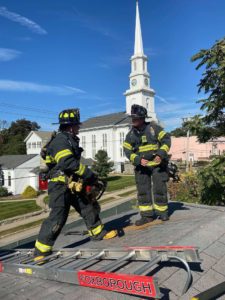Who is a member?
Our members are the local governments of Massachusetts and their elected and appointed leadership.
MMA Innovation Award winner, From The Beacon, February 2023

Using data analysis, Foxborough officials have reduced their firefighters’ use of PFAS-embedded turnout gear. (Photo courtesy town of Foxborough)
Amid concerns about PFAS health hazards for fire departments, the town of Foxborough has reduced exposure to the “forever chemicals” through an analysis of data and a regional partnership.
Working with the Southeastern Massachusetts Regional 911 District, Foxborough analyzed 911 call data to determine which incidents required the use of full turnout gear, which contains per- and polyfluoroalkyl substances, and limited the use of that gear to only the most hazardous calls. Based on historical data, the town believes the change could reduce firefighters’ PFAS exposure by 60%.
“The big hope is that we reduce exposure, obviously, and improve the health and wellness of our workforce,” said Foxborough Fire Chief Mike Kelleher.
PFAS was a known component of firefighting foam, but fire departments more recently discovered that firefighting gear also contained the chemicals, Kelleher said. The chemicals exist in the moisture barrier within the firefighters’ full turnout gear, and the industry will likely need years to identify a practical replacement. In the meantime, firefighters are stuck wearing the gear while studies have shown links between PFAS and serious health problems. Kelleher said several of the town’s retired firefighters have developed cancers consistent with those connected to PFAS.
In the meantime, fire departments have been trying to limit exposure, including storing equipment in a separate vehicle compartment when not using it. Firefighters still face exposure, however, when they are wearing the full gear but aren’t using their self-contained breathing apparatus, which blocks toxins.
Foxborough found an answer within the regional 911 district, which provides services for Bristol County and the police and fire departments of Foxborough, Easton, Mansfield and Norton. As part of its protocols, the district had been using software to classify each emergency call with letters A through E — A being the least serious, and E being the most hazardous.
Studying the data, Kelleher noted that the lower-risk calls didn’t require the use of full turnout gear. Last summer, he and 911 District Executive Director Robert Verdone analyzed previous calls and roughly 3,600 911 call types, and they found that the call classifications were extremely accurate and could support a new turnout gear policy.
In September, Kelleher issued an order limiting the use of full turnout gear to calls classified as C through E, for incidents such as structure fires, vehicle fires and natural gas odors. For calls labeled A and B — which could include downed wires or carbon monoxide false alarms — firefighters could wear their station uniforms plus an emergency medical services coat or duty coat.
Foxborough Town Manager Bill Keegan said the change reflects the town’s willingness to consider new approaches.
“When you think things through, and understand why things are done the way they are,” Keegan said, “you can actually make very good changes in the best interests of the employees as well as the service itself.”
Foxborough is the only community in the 911 district to have made the change so far. Because the town relied on the 911 District’s existing software, training and protocols, the change hasn’t added any costs. Officials said they hope other departments consider similar changes, but they acknowledged that other communities might not have the resources to do so. They credited their regional partnership for making this happen.
“When we implement things in the best interests of the community … and we’re able to adapt them almost seamlessly to protect the fire service, our partners here,” Verdone said, “that’s a win for us.”
For more information, contact Rob Verdone at the Southeastern Massachusetts Regional 911 District at rverdone@semrecc.gov.